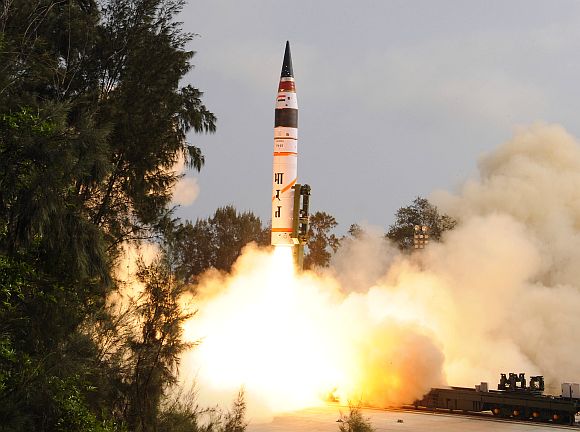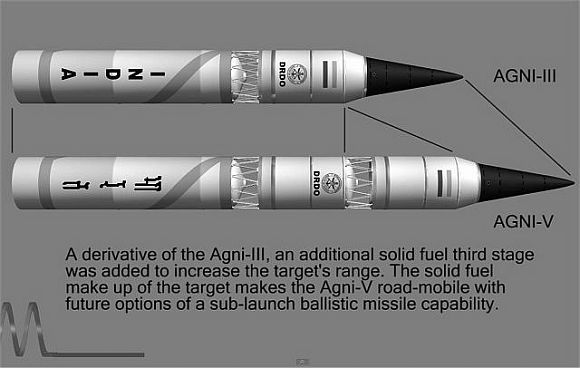 | « Back to article | Print this article |
Production of Agni V to begin in a year's time: DRDO chief
India has emerged as a major missile power with the successful launch of Agni V ballistic missile and the production of the weapon system would start in a year's time, Defence Research and Development rganisation chief V K Saraswat said on Thursday.
"This launch has given a message to the entire world that India has the capability to design, develop, build and manufacture missiles of this class, and we are today a missile power," Saraswat said after the launch of the 5000 km range surface-to-surface inter continental ballistic missile.
The DRDO chief said that the missile launch was a major milestone in the strategic defence preparedness of the country.
"We are going to conduct two more tests and that will be validation tests..., and then the production of this system will start. It is going to take a year maximum," he said.
Saraswat said that he expected the missile to be inducted into the armed forces in the next two years.
He said the successful launch of Agni V was just the beginning of a new series of missiles.
"We go from here to many other missiles which will have capability for MIRV (Multiple Independently Targetable
Re-entry Vehicle), for anti-satellite system, which will also be built using this technology for launching micro, mini and nano satellite to meet the requirement of the armed forces on very, very short notice," he said.
Please click NEXT to read further...
'More than 80 per cent of the missile is indigenous'
Saraswat said that barring some electronic components, the Agni V was a completely indigenous product.
"More than 80 per cent of the missile is indigenous, except for the electronic components which we import... Everything has been designed, developed and produced in our industry and our laboratory," he said.
The DRDO chief said that his organisation was working on a very tight time schedule when it came to production and deployment of the missile.
"We have a very tight time schedule on that. I expect that after the completion of its mandatory trials, it would be inducted in the services in the next two years to come. We have a very clear roadmap for development of missile system," Saraswat said.
Giving details of today's launch, Saraswat said that the missile "lifted off at 0807 hours today. It is a three-stage missile, the first stage burned out, gave the required velocity and after that it separated."
Saraswat said that similarly the missile reached its second and third phases and after that it reached the crucial re-entry phase which is the most difficult phase for any ballistic missile of this range.
'India no longer susceptible to techno blackmail by others'
"All the re-entry conditions were perfect. The missile travelled through the re-entry, got converted into a fireball and finally (hit the target).....and all the payload parameters which result in the detonation of the warhead took place," Saraswat said.
The DRDO chief said that the launch was monitored by three ships deployed in Indian Ocean, 5000 kilometers away, and radars were also there tracking the complete trajectory.
Saraswat said that that the launch of the missile despite regimes placed by the developed world showed that India was becoming self-reliant in missile technology.
"The missile has been achieved despite the stringent missile control regimes, which developed countries have imposed on us and that shows the self-reliance in the area of this technology is now becoming a reality," he said.
The DRDO chief also said that India had made a lot of progress in missile technology following which it was no longer susceptible to blackmail by others.
On how indigenous technology had contributed to the launch of Agni V, Saraswat said that most of the components like rocket motors and propellants had been made within the country. It is 80 per cent indigenous, he said.
"When I said 80 per cent, the propelling system, the rocket motors, the composite rocket motors, the propellants, the control system elements, onboard computers, mission computers, all these softwares, complete mission softwares are part of indigenous development exercise," he said.
"That gives us the required strength that nobody can now blackmail us as far as this technology is concerned," he said.
"Today we have the capability because our electronics, our navigation systems are highly miniaturised. We have developed a system on chip (such) that complete missile electronics can be resident on a single chip," he said.
TOP photo features of the week
Click on MORE to see another set of PHOTO features...



